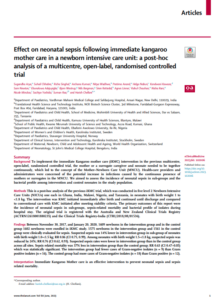
View Resource
Background
To implement the immediate Kangaroo mother care (iKMC) intervention in the previous multicentre, open-label, randomised controlled trial, the mother or a surrogate caregiver and neonate needed to be together continuously, which led to the concept of the Mother–Newborn Care Unit (MNCU). Health-care providers and administrators were concerned of the potential increase in infections caused by the continuous presence of mothers or surrogates in the MNCU. We aimed to assess the incidence of neonatal sepsis in sub-groups and the bacterial profile among intervention and control neonates in the study population.
Methods
This is a post-hoc analysis of the previous iKMC trial, which was conducted in five level 2 Newborn Intensive Care Units (NICUs) one each in Ghana, India, Malawi, Nigeria, and Tanzania, in neonates with birth weight 1 to <1.8 kg. The intervention was KMC initiated immediately after birth and continued until discharge and compared to conventional care with KMC initiated after meeting stability criteria. The primary outcomes of this report were the incidence of neonatal sepsis in sub-groups, sepsis-related mortality and bacterial profile of isolates during hospital stay. The original trial is registered with the Australia and New Zealand Clinical Trials Registry (ACTRN12618001880235) and the Clinical Trials Registry-India (CTRI/2018/08/01536).
Findings
Between November 30, 2017, and January 20, 2020, 1609 newborns in the intervention group and in the control group 1602 newborns were enrolled in iKMC study. 1575 newborns in the intervention group and 1561 in the control group were clinically evaluated for sepsis. Suspected sepsis was 14% lower in intervention group in sub-group of neonates with birth weight 1.0-<1.5 kg; RR 0.86 (CI 0.75, 0.99). Among neonates with birth weight 1.5-<1.8 kg, suspected sepsis was reduced by 24%; RR 0.76 (CI 0.62, 0.93). Suspected sepsis rates were lower in intervention group than in the control group across all sites. Sepsis related mortality was 37% less in intervention group than the control group; RR 0.63 (CI 0.47–0.85) which was statistically significant. The intervention group had fewer cases of Gram-negative isolates (n = 9) than Gram positive isolates (n = 16). The control group had more cases of Gram-negative isolates (n = 18) than Gram positive (n = 12).
Interpretation
Immediate Kangaroo Mother care is an effective intervention to prevent neonatal sepsis and sepsis related mortality.